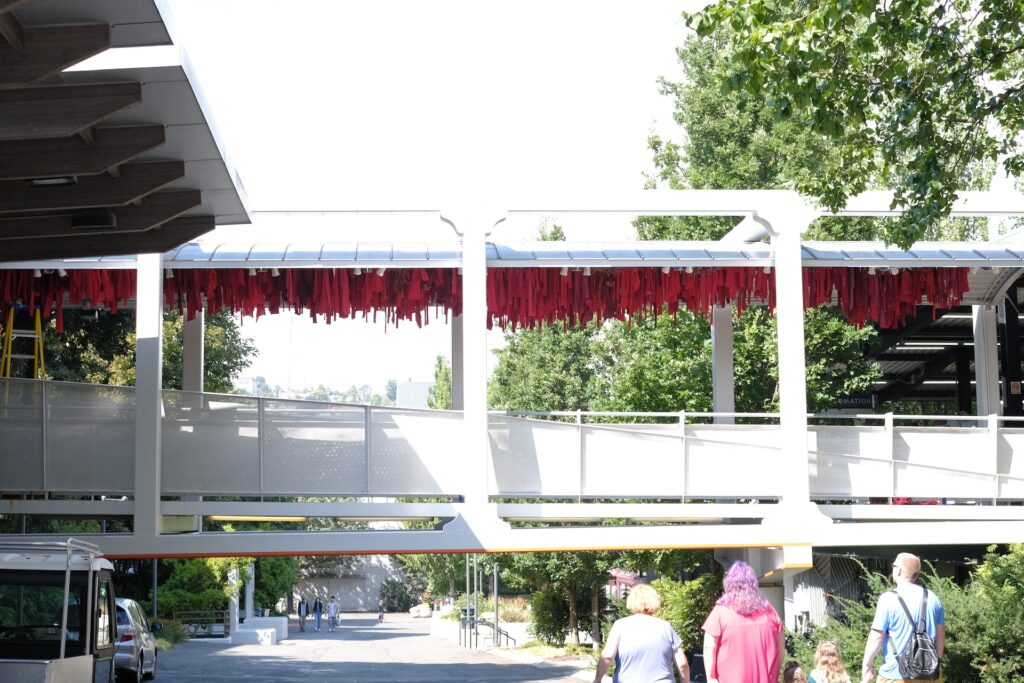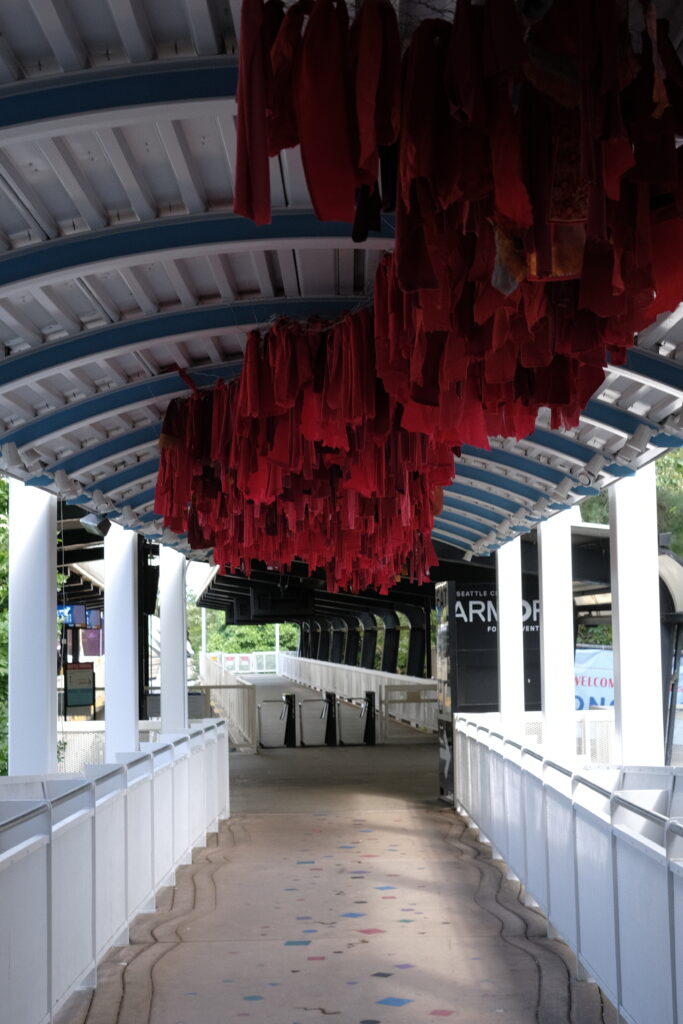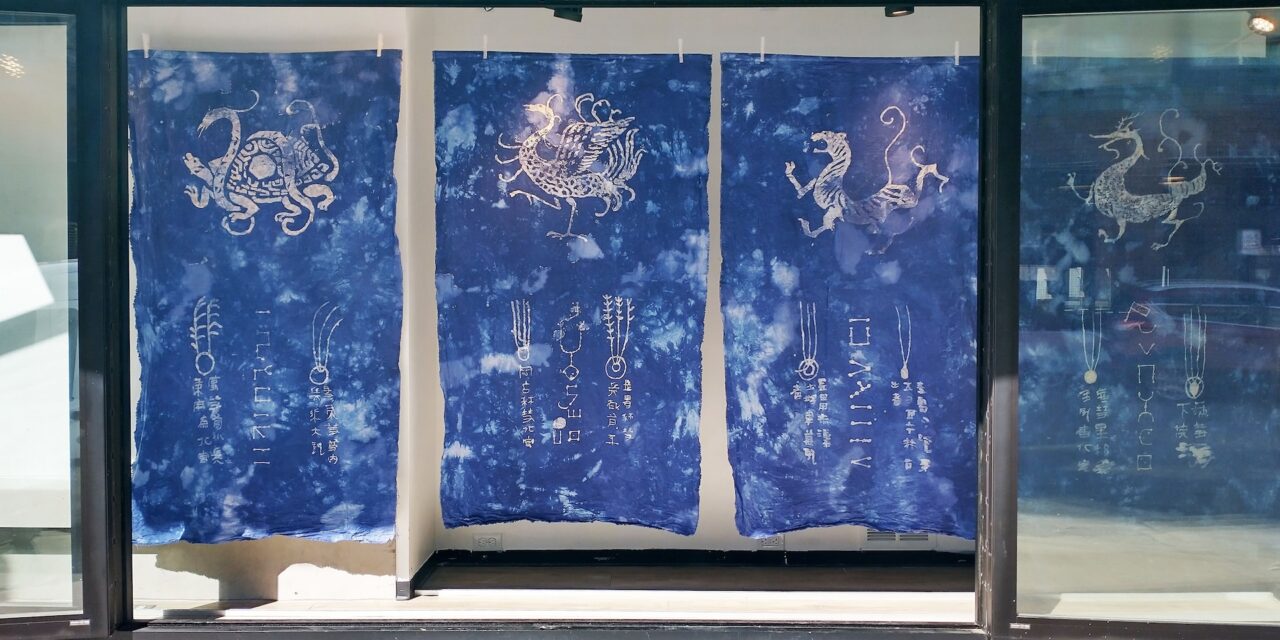The following is an interview with May Kytonen, a Seattle-based visual artist who is also Director of Cohorts for the Brehm Center.
Lauren: Can you tell us a little bit about your art and your creative process?
May: My art practice really is just an exploration around my identity as a mixed Asian-American person. I explore themes around family, heritage, and ancestry work. A lot of it comes out of my own personal story and experiences being an Asian-American person, particularly in the Pacific Northwest. I spent my childhood in Spokane, and so a lot of my life stories are informed by being a minority in that community. And then being a young adult on the west side here, mostly in Seattle, and also Yelm, Washington. That definitely informs my practice.
When I do artist talks, I start with the story of a naptime gone wrong. When I was three or four years old, I was supposed to be napping, but I didn’t want to sleep. So I brought my little sister into my top bunk with me and started drawing on the wall in crayon. What I started drawing was my own version of a map between the US and Taiwan, where my grandparents, aunts and uncles, and all my family on my mom’s side reside.
I would join these lines and say, “Here’s our house in Spokane, and here’s our family in Taiwan. And here’s where we took the airplane,” telling her the story. I find that my work is a continuation of that, almost like a cartography of belonging. That’s how I’ve articulated it—finding a map back to where I belong, a map between cultures.

Encrypted

In My Element
The materials I use to explore this are usually fibers. I started out studying fibers in undergrad. So weaving, textile kind of work. I still work in fibers, but I also moved into collage and paper. One of my earlier bodies of work was paper as fiber—making yarn out of paper and then using that yarn to knit or crochet larger sculptural forms.
I worked with newspaper and used that to demonstrate story and language holding identity and community. I mean, newspapers literally tell the story of a community. So, I was thinking about the stories they tell and then how I’m telling a story with that material, as well.
Lauren: You mentioned being an artist in this location. Have you noticed any particularities to being an artist in the Pacific Northwest?
May: Yeah, I mean, there’s the cultural element that so many people have already spoken to around the Seattle freeze. And there are two responses to that as an artist. First, I don’t know that the Seattle freeze is inherently bad. I think there’s a cultural element to being in one’s own bubble or element, and as an artist you have to be in your bubble to create. In that sense, the freeze could serve the artist’s practice. As an artist, you have to develop an inward life; that’s something you benefit from.
On the flip side, there are people who come into Seattle as artists and feel really isolated. But I think because there’s that need, people do reach out to each other. They need community. I’ve seen that overlap, particularly in the Seattle region. I’m more involved in arts nonprofits, city-hosted art spaces, and community spaces here.
An example is the Artists of Color Expo and Symposium (ACES) that’s been hosted by Shunpike, which is an art nonprofit in the city of Seattle. They host people from all over the Pacific Northwest, and they host an annual conference for artists of color. So, that’s a way that the city and organizations of artists have acknowledged the cultural things that make it challenging to be an isolated artist and then made space to connect.
When I first went to ACES, I was living in Eastern Washington, feeling really isolated, both as a person of color and as an artist. To be brought into that space made me feel like I had community and kindred spirits.
Lauren: Is there a common thread or theme in your artwork?
May: Yeah, I would say that belonging piece, that cartography of belonging. I think a lot of my work speaks to the specifics around being Asian-American. But I also have work that asks, where do we belong in the bigger story of humanity? The overarching themes have been belonging and identity for me.

Path of the Sky Dragon
Lauren: You’ve had lots of exhibits around the Greater Seattle area. Do you have a favorite one?
May: Honestly, I think the project I got to do for the Seattle Center, “Path of the Sky Dragon,” was a dream come true. I really wanted to work in the public art sector, and I’ve gotten opportunities to do smaller, window front projects through a couple of cities—Auburn, Tacoma, and Seattle, as well. And this was an opportunity to work from outside, not behind the glass, so to speak.
The project was a hanging fiber installation that was over the pathway between the armory and the monorail at the Seattle Center, and it was inspired by the concept of the dragon in Eastern tradition. The dragon is seen as benevolent and wise, and a protective kind of entity. My dragon was an abstract dragon form that’s watching over that pathway for people.
It was really a team effort. I had a wonderful project manager from the Seattle Office of Arts & Culture who supported me through the whole journey. I had riggers who helped me set it up. I was very pregnant when it was finally time to go up, so I needed lots of help. My spouse was such a partner in crime, helping me even to construct it.
When we were putting up the project, it was fun to see people stop and say, “What is going on? Is this for the New Year celebration? What is it supposed to be? Oh, it’s a dragon? Where’s its head?” It’s kind of funny, you know, depending on your experience with art, you might expect things to be more didactic or more clear as to what it’s representing. But I liked it being abstract.
Working in the fibers was really fun because then the wind could interact with it; it had movement. That was probably one of my favorites. I just feel like I learned so much, and I love being able to collaborate with the City of Seattle.
I also really like art being accessible to people. I love that anyone who is just out in public could see it.

Path of the Sky Dragon
Lauren: How would you describe the connection between your art and your faith?
May: I feel like my faith is just a part of my person. It’s infused into who I am, so it’s infused into my art, whether explicit or not.
It’s interesting, I think people who are artists but also people of faith have different approaches to their art making. Some really see it as a place to explicitly express elements of their faith. So they might work in imagery that’s more Christian based, or they make work explicitly for the church or through the church. Mine tends to be more informed by my faith, but not speaking directly to elements of the Christian narrative. But there are themes, so I’ll share a couple of examples.
One was the project I did initially for a conference through the Brehm Center that was called “In the Fabric of Space and Time.” I did these banner installations that were constellations. It was like weaving our human narrative into the one that’s written into the stars. Ultimately, as a person of faith, I see that God holds the bigger story. And I think throughout history, nations and people over generations have looked up at the stars as part of their storytelling, or they make stories about where they belong in the cosmos. So thinking through those themes was informed by my own faith practice.
The “Path of the Sky Dragon” is another example. Of course, there’s a whole conversation about syncretism versus inculturation, but I think I’ve been super interested in calling out similarities between other faith traditions, artistic or spiritual practices, and Christianity. So when I heard about the Sky Dragon being a benevolent form in Chinese mythology, I thought there’s a potential parallel with the Holy Spirit. And I just love thinking about making something that could be a placeholder for prayer. Even with the material I used, I used recycled fabric, so it was literally people’s clothing that I used—people’s bodies wore them. So I’m thinking about how this thing is also made up of remnants of people’s bodies. In a way, it’s a body, too, that’s made up of people’s stories. It’s a placeholder, a representation of people’s stories and the community that it comes from.
My faith is subtly infused into my work. I’m not out there saying, this is a Christian thing. But it’s part of who I am, so it’s going to come out in my work.
Lauren: Jumping off the Christianity piece, you are an artist who helps other artists through the Brehm Center. Would you say you help them live into their calling as artists and people of faith? Or help them navigate that?
May: Yeah, I think it is like navigating. It’s integration work—how do you integrate your faith life and your art practice? Also, how do you integrate your art practice with your faith community? The Brehm Residency that I oversee is all about that integration and helping artists to see how they are empowered and equipped to be real partners in the work of a church or ministry. We affirm their call in that way.
It’s also for ministry leaders to be seen in their work and to be given tools to partner well with artists. We also encourage and support them in their work. Ministry can be a heavy burden, and it’s not meant to be done alone. So we provide that community piece; it’s all about relationship. We support artists, churches, and ministry leaders.
Lauren: How has that work been meaningful for you?
May: Well, when I first joined the Brehm Center, I was really wrestling with those questions for myself. I had been in full-time ministry for six years prior and felt like my art practice and my ministry were very separate, disjointed spheres. I was longing for integration. Some of it was identifying, why was there a division? Why did I feel that? And then what were the ways that I could bridge the gap or bring my community in alongside me?
As I’ve been in this work, all along there have been people who’ve been so affirming of my call inside of the church and outside. People who’ve been partners in it with me. And I think what I’m really encouraged by in my work is seeing artists and ministry leaders mutually support one another and cheer each other on. I think that’s huge. I’m also encouraged because, as a facilitator, I get to be present to everyone’s story. It’s a gift to be in that work.
Lauren: Is there anything else you want people to know about your art or your process?
May: Yeah, my art practice has been this ongoing relationship, where at first I held it at arm’s length because I was unsure about its place in my life and its place in my calling—how God saw me or what he was actually calling me to. And now my art practice is like a friend who’s with me, not just to share my story, but to connect me with other people. As I focus my work on this exploration of belonging, I find belonging, getting to be part of these communities, getting to share my story and to help other people be seen in their stories. So yeah, it’s a gift, I think. Being able to be an artist is a gift.
“Path of the Sky Dragon” photos credited to Ricky Reyes. All other photos, May Kytonen. You can find more of May’s art on her website.

